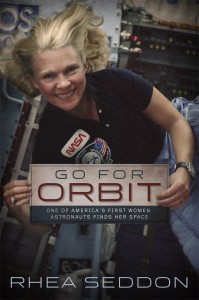g=Gravity

Earth exerts a pull.
From the time of our conception we have felt gravity. It is the pull of the Earth on all of us and everything else. Because we have defined it this way, we say we are at “1g” as we walk around.
But did you know that it is possible to feel more than 1g – or less than 1g – here on Earth or in other strange places? I have experienced a whole range of gs.
Some were fun, others scary.
When I began my training to fly aboard the Space Shuttle, I had to learn a great deal about gs. My indoctrination began when I started flying in the NASA jets, the T-38s. Going 700 mph, if you turn sharply (as if a fighter jet would do when trying to shoot down another plane in a dogfight) you will begin to feel g-forces pressing you into your seat. Pull hard enough and the blood will be forced from your head to your feet and you will pass out. In one of my jet training sessions the pilot started a turn and increased the gs until I began to feel like I might pass out – and then taught me to strain down to keep the blood in my head. Fighter pilots wear “g-suits” that compress their legs and abdomen to do the same thing.

T-38s Turning.
Then there is the opposite phenomenon when you reach the top of a roller coaster and start down. Have you felt your arms float up? Well, you were experiencing zero-g – falling downward.
NASA makes use of this effect with the zero-g airplane. It flies up and down like a roller coaster and in the dive downward, the contents of the plane (including the passengers) will float for about 30 second until the plane starts upward again. It is a good way to simulate for short periods what an astronaut will experience on orbit.

Zero-G fun.
Before our first flights into space, some members of my astronaut class were taken to a large centrifuge at Brooks Air Force Base in San Antonio to experience g-forces so we would know what to expect during launch. The centrifuge started whirling around slowly then faster and faster until it built up to 3 gs and held there. It felt like an elephant was sitting on my chest. I realized it would be difficult to reach switches beside my seat and above my head, but I knew I could do it if necessary, with some effort.

Centrifuge.
During the Space Shuttle launch there is a short increase of gs at lift-off, like you might feel when a race car suddenly accelerates. The ride after that is a little rough, but smooths out when the boosters come off at launch plus two minutes. Then, when almost to orbit, traveling 17,000 mph, the gs of acceleration begin to build until you reach 3 gs for 30 seconds or so – just like in the centrifuge.

Weightless at last.
When I launched on April 15, 1985, thirty-four years ago last month, I knew what to expect – I thought.
When the Shuttle reached orbital velocity and the main engines cut off, I unbuckled from my seat. Floating without gs for the next week was amazing.
Indescribably amazing!
Maybe one day you’ll get to do that. I think tickets may be available soon!
If you’d like to receive my blog to your inbox each month, we’d love to add you to our email list. If you have not yet signed up, please do so today by clicking here.
Follow me on Twitter and Facebook!



Can you address the G-Suits that high performance jet aircraft pilots wear? I know the Navy Blue Angles don’t wear them because they might affect formation flight safety. So they just train for the high g-loads and suck it up. Do you have any interesting G-suit stories you could add to your site?